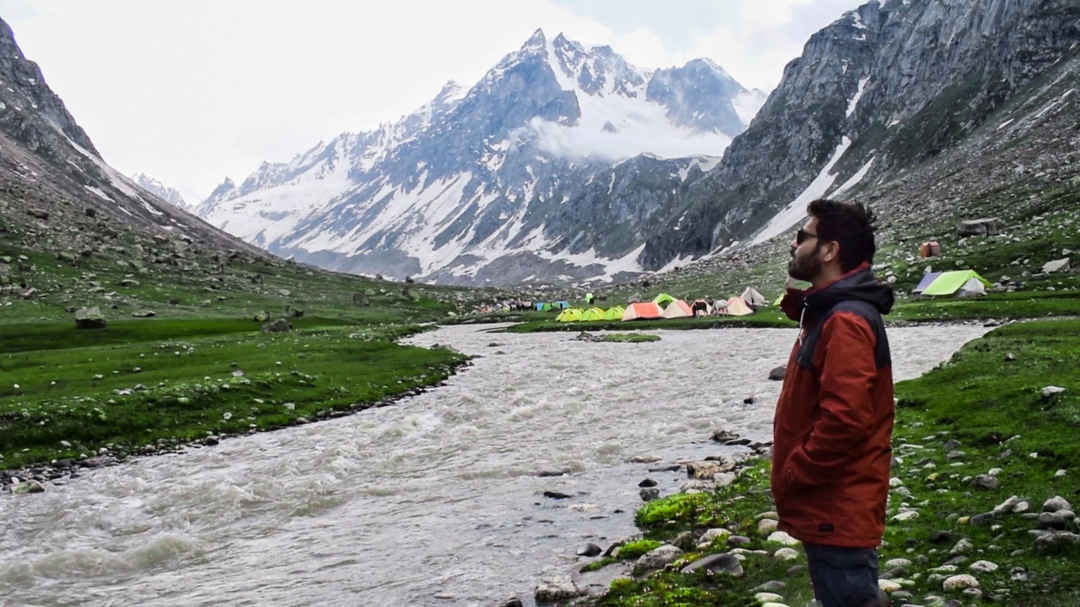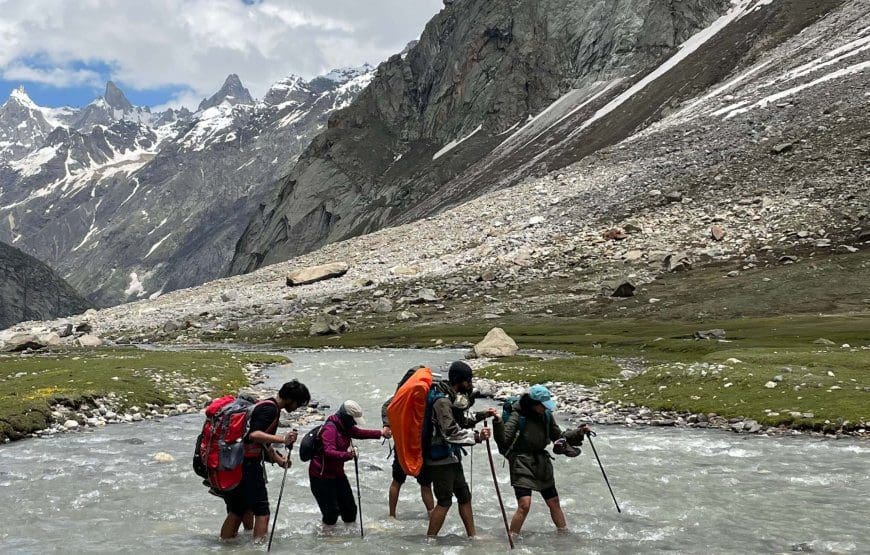Balu Ka Ghera
Published on June 30, 2025
If you’re planning the iconic Hampta Pass Trek, there’s one campsite that captures both the beauty and the anticipation of crossing the mighty pass — Balu Ka Ghera. Translated as the "Heap of Sand," this campsite is nestled in a wide alpine valley surrounded by snow-capped peaks and glacial streams. It serves as the final stop before ascending to the Hampta Pass, making it one of the most crucial and mesmerising points on the trek.
Located at an altitude of approximately 12,000 feet (3,660 meters), Balu Ka Ghera is known for its dramatic landscapes, high mountain vibes, and surreal natural beauty. In this article, we’ll explore why Balu Ka Ghera is more than just a campsite — it’s a spiritual and scenic pause before the grand adventure ahead.
Where is Balu Ka Ghera?
Balu Ka Ghera is located in the Lahaul and Spiti district of Himachal Pradesh, along the trail that leads from Chika to Hampta Pass. It is approximately 5–6 km from the Chika campsite and takes about 4–5 hours of trekking to reach, depending on your pace and weather conditions.
The trail to Balu Ka Ghera runs along the Rani Nallah stream and passes through:
-
Wildflower-filled meadows
-
Rock boulders and ridges
-
Wooden bridges over streams
-
Snow patches during early and mid-season

The Trek from Chika to Balu Ka Ghera
This segment of the trek is often described as the most scenic stretch before the actual Hampta Pass crossing. The trail gradually ascends along the river and unfolds some breathtaking views of the Dhauladhar ranges.
Key highlights on the way:
-
Waterfalls and icy stream crossings
-
Colourful alpine flowers in summer
-
Rugged boulder-strewn trails
-
Occasional snow bridges in June and early July
The overall ascent is moderate but steady. This is also the point where you’ll start feeling the effects of altitude, so proper hydration and rest breaks are essential.
Why is it Called “Balu Ka Ghera”?
The name "Balu Ka Ghera" means "Circle of Sand" or "Heap of Sand". The campsite is located on a flat bed of fine glacial sand and silt left behind by the retreating glaciers of the upper Hampta Valley.
Interestingly, when you arrive at the campsite, you’ll notice:
-
Soft sandy patches on the riverbank
-
A wide, flat valley flanked by high cliffs
-
The sound of water rushing through braided glacial streams
This makes it an ideal spot for pitching tents — flat, open, and with a water source nearby.
Camping Experience at Balu Ka Ghera
Camping at Balu Ka Ghera is a dream for any trekker or nature lover. Surrounded by towering peaks and often covered in fog and low clouds, it has an ethereal feel.
What makes it special:
-
Stunning sunset and sunrise views over snow-covered peaks
-
Clear night skies full of stars (perfect for astrophotography)
-
A peaceful environment with only the sound of wind and water
-
Opportunity to rest well before the challenging ascent to Hampta Pass
Most trekking groups set up dome tents or alpine tents here with a shared dining tent and toilet tents nearby.
Weather at Balu Ka Ghera
At 12,000 ft, Balu Ka Ghera has unpredictable and rapidly changing weather. Even in summer, temperatures can drop drastically post-sunset.
Typical weather conditions:
-
Daytime: 10–15°C
-
Nighttime: 0 to -5°C (can go lower in June/September)
-
Sudden rainfall, snowfall or fog is common
Trekkers are advised to carry:
-
Waterproof and windproof jackets
-
Thermals, gloves, and warm socks
-
Rain cover for the backpack and shoes
Photography & Nature Highlights
For photographers and nature enthusiasts, Balu Ka Ghera is a goldmine. You’ll find plenty of moments to capture, including:
-
Reflections of the mountains in the glacial stream
-
Shepherds and sheep herders during certain months
-
Rare alpine flowers and plants like Brahma Kamal (seasonal)
-
Snow-draped landscapes in early-season treks

Altitude Awareness & Acclimatisation
Since Balu Ka Ghera sits at 12,000 ft, this is the point where altitude sickness can begin to affect some trekkers. It’s important to:
-
Drink 3–4 litres of water daily
-
Avoid over-exertion
-
Stay warm and well-nourished
-
Inform the trek leader immediately if you feel a headache, nausea, or fatigue
This site is often chosen as a long acclimatisation halt before attempting the Hampta Pass the next morning.
Challenges at Balu Ka Ghera
While it’s beautiful, this is also a rugged and remote location. Some common challenges include:
-
Cold nights
-
Slippery rocks and water crossings
-
Limited shelter from wind/rain
-
No mobile network
But for many, overcoming these minor hardships becomes part of the adventure.
Eco-Responsibility
Balu Ka Ghera is an untouched natural area. Trekkers must follow Leave No Trace principles:
-
Do not litter
-
Carry biodegradable toiletries
-
Use designated toilet tents only
-
Do not disturb flora and fauna
This helps preserve the area for future trekkers and keeps the Himalayas beautiful.
The Soul of Hampta Pass
Balu Ka Ghera is more than just a resting point — it’s the soul of the Hampta Pass Trek. It represents the point where nature shows its power, beauty, and silence all at once. The peaceful ambience, panoramic views, and anticipation of the upcoming pass crossing make this site emotionally and visually unforgettable.
If you’re trekking to Hampta Pass, cherish your time at Balu Ka Ghera — breathe in the thin mountain air, watch the stars, and let nature prepare you for what lies ahead.
